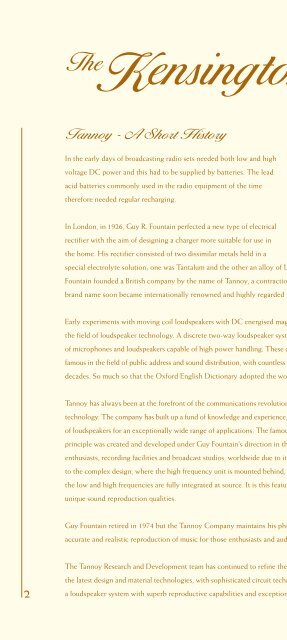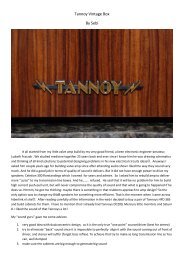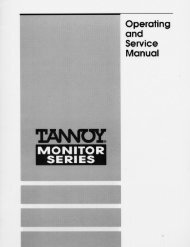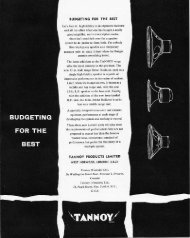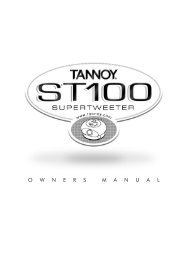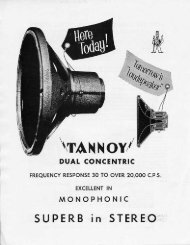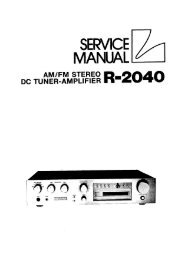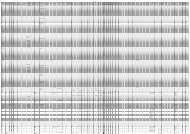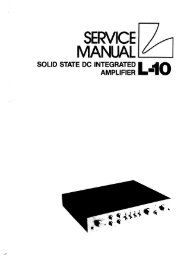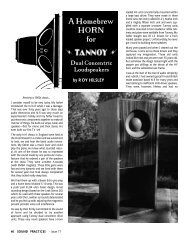Kensington Manual A/W For Print
Kensington Manual A/W For Print
Kensington Manual A/W For Print
You also want an ePaper? Increase the reach of your titles
YUMPU automatically turns print PDFs into web optimized ePapers that Google loves.
The <strong>Kensington</strong><br />
The<strong>Kensington</strong><br />
In combining the best of traditional crafts with the latest production and design skills Tannoy presents the <strong>Kensington</strong><br />
loudspeaker. The <strong>Kensington</strong> embodies the Tannoy philosophy. Cabinets in selected hardwoods are hand finished and<br />
polished to a standard that is unsurpassed.<br />
The <strong>Kensington</strong> is a truly special loudspeaker. The speaker uses the classic Alcomax 3 version of the famous Tannoy Dual<br />
Concentric driver. This magnet system endows the Dual Concentric with an exceptional transient response and increased<br />
sensitivity. This high performance driver is installed in braced birch-ply and particleboard cabinet with hardwood veneers<br />
and solid wooden mouldings. Silver-plated van den Hul wiring is used throughout. High frequency energy can be tailored<br />
through a high current gold-plated switch block with controls for both treble energy and roll off. Low frequency alignment<br />
is through the Tannoy Distributed Port System (DPS). The specially designed twin-roll impregnated fabric surround used<br />
on the drive unit's cone ensures midrange purity combined with tight, controlled bass.<br />
Tannoy - A Short History<br />
In the early days of broadcasting radio sets needed both low and high<br />
voltage DC power and this had to be supplied by batteries. The lead<br />
acid batteries commonly used in the radio equipment of the time<br />
therefore needed regular recharging.<br />
In London, in 1926, Guy R. Fountain perfected a new type of electrical<br />
rectifier with the aim of designing a charger more suitable for use in<br />
the home. His rectifier consisted of two dissimilar metals held in a<br />
special electrolyte solution; one was Tantalum and the other an alloy of Lead. So successful was this invention that Guy<br />
Fountain founded a British company by the name of Tannoy, a contraction of the words 'Tantalum' and 'Alloy', and this<br />
brand name soon became internationally renowned and highly regarded in all aspects of sound reproduction.<br />
Unpacking Instructions<br />
Unfasten the bottom of the carton and remove all staples. Fold the end leaves out of the way and remove the packing<br />
tray to reveal the plinth and bottom of the loudspeaker cabinet. Locate and remove from the carton the accessories pack.<br />
Turn the carton and loudspeaker over so that the cabinet now stands on the floor inside the carton. Lift the carton upwards<br />
to reveal the loudspeaker.<br />
Examine all packing material and inspect the carton for signs of external damage. If there is evidence of excessive mishandling<br />
in transit, resulting in damage to the loudspeaker, inform the carrier and supplier immediately. Always keep the packing<br />
in such circumstances for subsequent examination.<br />
Early experiments with moving coil loudspeakers with DC energised magnets proved to be the company’s first foray into<br />
the field of loudspeaker technology. A discrete two-way loudspeaker system followed in 1933 and shortly after a range<br />
of microphones and loudspeakers capable of high power handling. These developments led the company to become world<br />
famous in the field of public address and sound distribution, with countless prestigious installations completed in subsequent<br />
decades. So much so that the Oxford English Dictionary adopted the word Tannoy as the generic term for a PA system.<br />
Tannoy strongly suggests that you store the complete packaging set for possible future use.<br />
Tannoy has always been at the forefront of the communications revolution, developing its own equipment and production<br />
technology. The company has built up a fund of knowledge and experience, which has proved invaluable in the development<br />
of loudspeakers for an exceptionally wide range of applications. The famous Tannoy Dual Concentric loudspeaker driver<br />
principle was created and developed under Guy Fountain's direction in the late 1940’s. It is still highly regarded by music<br />
enthusiasts, recording facilities and broadcast studios, worldwide due to its unique point source dispersion properties. Due<br />
to the complex design, where the high frequency unit is mounted behind, and concentrically with, the low frequency unit,<br />
the low and high frequencies are fully integrated at source. It is this feature that gives the Dual Concentric driver such<br />
unique sound reproduction qualities.<br />
Initial Positioning<br />
Locate the loudspeakers so that the favourite listening position is approximately 15° from the axes of the cabinets. The<br />
axes of both cabinets should intersect at a point slightly in front of the listening position. Remember that the proximity<br />
of the loudspeakers to walls and corners will affect the sound. Some experimentation will probably be needed to fine-tune<br />
the stereo image depth and low frequency sound quality. Close-to-wall positions - and room corners more so - have the<br />
effect of increasing very low frequency sound energy. Reflective adjacent walls may upset the stereo image by causing<br />
unwanted reflections.<br />
The loudspeakers are designed to be used at least 1m from any sidewall or reflective surface and at least 0.5m away from<br />
a rear wall. Only in this position will their exceptional stereo image depth capabilities be realised.<br />
Guy Fountain retired in 1974 but the Tannoy Company maintains his philosophy and, as such, remains dedicated to the<br />
accurate and realistic reproduction of music for those enthusiasts and audio professionals around the world.<br />
Holes are provided in the base of the speakers for down-spikes that give maximum stability, these special floor coupling<br />
spikes are provided in the accessory pack and these should be screwed into the base of the loudspeakers, taking care not<br />
to over-tighten them. When the loudspeaker is installed in its upright position, the spikes should pass between the weave<br />
of your carpet to contact the floor beneath. Adjust the spikes for maximum stability.<br />
2<br />
The Tannoy Research and Development team has continued to refine the innovative Dual Concentric principle. Using<br />
the latest design and material technologies, with sophisticated circuit techniques in crossover design; Tannoy has produced<br />
a loudspeaker system with superb reproductive capabilities and exceptionally wide dynamic range.<br />
<strong>For</strong> polished wooden floors, hard nylon self-levelling 'ball-and-cup' feet are provided.<br />
3


